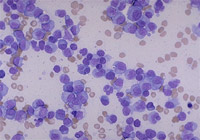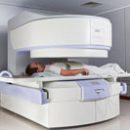Multiple myeloma is a tumor bone marrow disease, whose substrate is malignant plasma cells (myelomatic cells). To date, effective treatment can stop the progression of the disease and successfully combat its symptoms.
Content
Multiple myeloma (mm) is a tumor bone marrow disease, whose substrate is malignant plasma cells (myelomatic cells).
Bone marrow is an organ located in flat bones, such as ribs, vertebrae, skull, pelvic bones. One of the main functions of the bone marrow - the production of blood cells. Bone marrow produces various blood cells: erythrocytes carrying oxygen in tissue, leukocytes forming the immune system, platelets that ensure blood clotting and stopping bleeding.
The immune system consists of various cells, the main task of the immune system - the fight against infections. Lymphocytes are some of the cells that make up the complex complex of the immune system. Lymphocytes are divided into two classes - T-lymphocytes and in-lymphocytes. Plasma cells are the most mature in-lymphocytes. Normal plasma cells secrete and distinguish various immunoglobulins that carry out humoral immunity and the protection of the body from infections.
Healthy blood cells are breeding ordered and controlled, obeying certain processes in the body.
 At multiple myeloma, the plasma cell becomes anomalous, malignant, uncontrollably multiplies, as a result of the progression of tumor in the bone marrow, the number of malignant plasma cells of one species increases dramatically. They fill the bone marrow and interfere with the production of normal blood cells of all three types. As a rule, these cells synthesize one type of pathological immunoglobulin, the production of normal immunoglobulin decreases, which causes the development of immunodeficiency and the high frequency of infectious complications. Pathological protein, which produces melting cells, strikes the kidneys.
At multiple myeloma, the plasma cell becomes anomalous, malignant, uncontrollably multiplies, as a result of the progression of tumor in the bone marrow, the number of malignant plasma cells of one species increases dramatically. They fill the bone marrow and interfere with the production of normal blood cells of all three types. As a rule, these cells synthesize one type of pathological immunoglobulin, the production of normal immunoglobulin decreases, which causes the development of immunodeficiency and the high frequency of infectious complications. Pathological protein, which produces melting cells, strikes the kidneys.
Melo man is usually called «Multiple», T. To. , As a rule, several foci of neoplasms are found in the bones, which can lead to fractures. Namely: in the bones of the spine, pelvis, chest, shoulder and hip belt and even a skull, while not characteristic of the bones of the hands and feet, forearm and legs.
Sometimes altered plasma cells are found only in one, separately taken part of the body (usually in one of the bones). This disease is called solitary plasmocyte. Tactics of treatment in these cases is different. Patients as therapy are prescribed irradiation and, if possible, operational treatment with further regular control over the analysis of the blood, which is able to detect the further development of myeloma in a timely manner.
The prevalence of multiple myeloma - 7.5 cases per 100,000 people, the frequency of the disease increases with age. As a rule, people over 50 years old are sick.
The exact cause of the disease is not known.
Symptoms of multiple myeloma
Most often, the disease begins with pain in the spine, ribs, bones pelvis. In some patient, the first symptom forces to start a survey is a sharply increased EE. Often, patients complain of weakness, increased fatigue, in blood tests is revealed to reduce hemoglobin (anemia) or an increase in creatinine levels (renal failure). Symptoms related to the increase in blood calcium level can appear in patients with pronounced changes in bone tissue: loss of appetite, nausea, constipation, depression and drowsiness.
In many patients, frequent repeating colds, cough and other infections are becoming the first manifestations of the disease, cough and other infections, especially the inflammation of the lungs.
Diagnosis of myeloma
As a rule, the first patient examines the therapist, he also sends a patient myeloma for blood test for research. If the results of this analysis are alarming, he recommends consultation of a hematologist expert.
The hematologist is still on an outpatient admission appoints an extended blood and urine test, the results of which are coming from the laboratory after one or two weeks. Blood and urine are investigated by electrophoresis on the presence of parapretenes in them - pathological proteins secreted by cells of myeloma. In some laboratories, an even more accurate study method is available – Immunofixation. In addition, for the patient's diagnosis, the patient must be taken to the study of the bone marrow sample.
Most often, the patient is sent to the hematological department of the hospital.
Survey of bone marrow. Bone marrow fence is made from the rear surface of the pelvic bone or from the sternum. The resulting material is examined under a microscope to detect myeloma cells.
Bone marrow fence is performed under local anesthesia. The special needle is introduced into the bone, and with the help of the syringe, the bone marrow sample is gained. All manipulation takes 15 minutes. The patient experiences an unpleasant feeling, so in many medical centers, this analysis is carried out under local anesthesia. If, after taking the analysis, the patient experiences pain in the place of injection and complains of discomfort, you can take painful tools.
X-rays. X-ray image allows you to see the changes in the bones, characteristic of multiple myeloma, namely, the foci of the pouring of bone tissue and fractures. Usually take pictures of the skull, spine, chest, ribs, pelvis, shoulder and femoral bones. In some cases, computer tomography is performed (KT) or magnetic resonance study (MRI).
Urine tests. In urine tests (by electrophoresis or immunophixation), determine the special type of paraproeinate, which is called Bens-Jones protein. For research it is necessary daily amount of urine.
Blood tests. If the patient is diagnosed with myeloma, a hematologist prescribes a regular blood survey, in order to monitor the level of paraprotein in the blood, as well as monitor such phenomena as anemia, hypercalcemia and monitor the kidney function.
Metyhea treatment methods
Treatment of multiple myeloma pursues several purposes:
Modern medication treatment of multiple myeloma includes:
- The pathogenetic approach is the impact on the mechanisms for the development of the tumor and on the very malignant fabric - anti-corrosive means;
- Symptomatic approach - treatment of manifestation of the disease: improving the state of bone tissue - Bisphosphonates; Preparations that reduce the severity of anemia - erythropoietin; Anti-infectious means - antibiotics.
In the pathogenetic treatment of patients with multiple myeloma, there are currently two different strategies: intensive chemotherapy with subsequent transplantation of autologous bone marrow and only drug anti-therapy («Standard» Chemotherapy with cytostatic means, treatment with innovative drugs).
Intensive chemotherapy with subsequent autologous bone marrow transplantation. Intensive chemotherapy is carried out using high doses of drugs aimed at combating a tumor, which, moreover, should not damage the cells of their own bone marrow. Then, after the tumor decreases in response to a course of intensive chemotherapy (achieving an answer), the patient makes the cells of their own bone marrow for subsequent autotransplantation (patient transplan its cells) .
According to the results of many studies, the transplantation of autologous bone marrow in the newly ill patients has several advantages compared to «Standard» Therapy: Increases both the number of complete remissions and the life expectancy of patients in those patients who have passed successfully (a response to therapy was received, unwanted phenomena were eliminated). However, this method of therapy has a number of contraindications, including, first of all, the age of the patient and the presence of concomitant diseases. When making a decision on the method of treatment, the patient's consent for treatment is also taken into account.
«Standard» chemotherapy, As a rule, it is used in combination with steroid hormones (prednisone, dexamethasone) and includes the use of various chemotherapeutic agents: Melfalane, cyclophosphamide, vincristine and some others.
Drug therapy innovative drugs. Significant success is achieved in the treatment of patients with multiple myeloma over the past decade due to the introduction into the clinical practice of the new generation medicines - with a fundamentally different mechanism of action than the traditional («Standard») Chemotherapy. These include registered in the Russian inhibitor proteosome - Bortesomyb (Velcade) and Immunomodulator - Lenalidomid (Revlimid). The use of these drugs leads to an increase in the number of complete remissions and the unrecognizable life expectancy of patients. Both Velcade and Revlimide can be used in patients as anti-corrosive therapy with recurrence (exacerbation) of disease and induction therapy with subsequent bone marrow transplantation.
In addition to the treatment listed above, radiotherapy is used, which is effective for irradiating pain areas and bone destruction. And sometimes there is a need for a surgical operation to strengthen weakened bones, warning fractures, to remove a tumor that gives up vital centers, for example, in the spine.
The choice of a specific treatment regimen depends, first of all, from the individual characteristics of the disease in each particular patient, as well as from the views and approaches in one or another doctor. As the sick himself, and his family members can always ask the attending physician any questions that interest them regarding the state of health of the patient, the methods of its treatment and any problems associated with the disease. Many patients before deciding whether to agree on the proposed treatment option, they wish to consult another specialist to listen to several points of view.
Full cure of myeloma is a matter of the future, but today effective treatment is capable of stopping the progression of the disease for many years and successfully deal with its symptoms.









